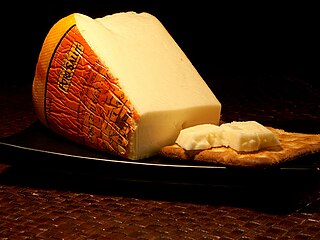
Port Salut is a semi-soft pasteurised cow's milk cheese from Pays de la Loire, France, with a distinctive orange rind and a mild flavour. The cheese is produced in wheels approximately 23 cm (9 inches) in diameter, weighing approximately 2 kg (4.4 lb).
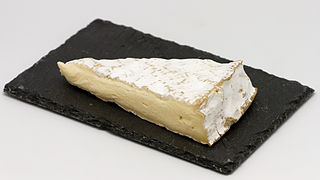
Brie is a soft cow's-milk cheese named after Brie, the French region from which it originated. It is pale in color with a slight grayish tinge under a rind of white mould. The rind is typically eaten, with its flavor depending largely upon the ingredients used and its manufacturing environment. It is similar to Camembert, which is native to a different region of France. Brie typically contains between 60% and 75% butterfat, slightly higher than Camembert.
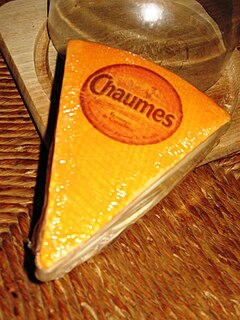
Chaumes is a cow's milk cheese from Saint-Antoine-de-Breuilh in the Périgord, made by traditional cheese-making processes. Translated literally, "chaumes" is French for stubble.

Annatto is an orange-red condiment and food coloring derived from the seeds of the achiote tree, native to tropical America. It is often used to impart a yellow or orange color to foods, but sometimes also for its flavor and aroma. Its scent is described as "slightly peppery with a hint of nutmeg" and flavor as "slightly nutty, sweet and peppery".

Oka is a semi-soft washed rind cheese that was originally manufactured by Trappist monks located in Oka, Quebec, Canada. The cheese is named after the town. It has a distinct flavour and aroma, and is still manufactured in Oka, although now by a commercial company. The recipe was sold in 1981 by Les Pères Trappistes to the Agropur cooperative.

Camembert is a moist, soft, creamy, surface-ripened cow's milk cheese. It was first made in the late 18th century in Camembert, Normandy, in northwest France. It is sometimes compared in look and taste to brie cheese, albeit with a slightly lower butterfat content than brie's typical 60% and 75% by weight.
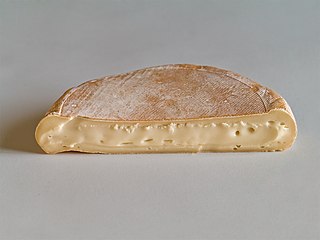
Reblochon is a soft washed-rind and smear-ripened French cheese made in the Alpine region of Haute-Savoie from raw cow's milk. It has its own AOC designation.

Époisses, also known as Époisses de Bourgogne, is a legally demarcated cheese made in the village of Époisses and its environs, in the département of Côte-d'Or, about halfway between Dijon and Auxerre, in the former duchy of Burgundy, France, from agricultural processes and resources traditionally found in that region.

Esrom, or Danish Port Salut cheese is a Trappist-style pale yellow semi-soft cow's milk cheese with a pungent aroma and a full, sweet flavour.
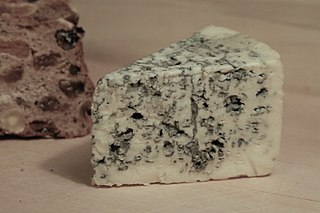
Ädelost is blue cheese from Sweden, made from pasteurized cow's milk. Swedish-made cheese, which is called "ädelost" or "ädel", is generally made from cow's milk and can be said to be a Swedish version of the French blue cheese.
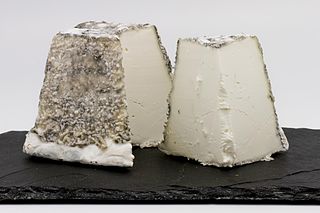
Valençay is a cheese made in the province of Berry in central France. Its name is derived from the town of Valençay in the Indre department.

Maroilles is a cow's-milk cheese made in the regions of Picardy and Nord-Pas-de-Calais in northern France. It derives its name from the village of Maroilles in the region in which it is still manufactured.

Derby cheese is a mild, semi-firm British cow's milk cheese made in Derbyshire with a smooth, mellow texture and a buttery flavour. Like most of the traditional British hard cheeses it was produced exclusively on farms and was typically sold at a younger age than its more famous cousins Cheddar and Cheshire. It has a pale, golden orange interior with a natural or waxed rind and ripens at between one and six months. In many respects Derby is similar to Cheddar in taste and texture, but with a softer body and slightly higher moisture content. When young it is springy and mild but as it matures subtle sweet flavours develop and the texture becomes firmer.

There are many different types of cheese. Cheeses can be grouped or classified according to criteria such as length of fermentation, texture, methods of production, fat content, animal milk, and country or region of origin. The method most commonly and traditionally used is based on moisture content, which is then further narrowed down by fat content and curing or ripening methods. The criteria may either be used singly or in combination, with no single method being universally used.
Cazelle de Saint Affrique is a soft-ripened, pungent cheese, made from pasteurized sheep's milk in the Midi-Pyrénées region of France. It is an artisan cheese, hand-fashioned in small rounds.

Trappist monks started producing Mont des Cats cheeses in 1890. The cheese is produced using cows milk from local sources and has a fat content of 50%. While maturing for at least two months the cheese is washed with salted water containing a dye made from annatto seeds which gives the rind its characteristic orange color.

Trappista is a traditional semi-hard cow's-milk cheese made in France, Belgium, Bosnia and Herzegovina and Hungary. It was created by the Trappist monks of Port-du-Salut Abbey in France.

Abbaye de Timadeuc Cheese is a cheese produced in a monastery by Trappist monks. This cow's milk cheese is an uncooked pressed cheese.
















